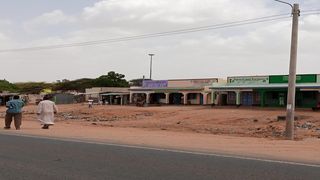
Madogo in Tana North.
| Stephen Oduor | Nation Media GroupNews
Premium
Shashamane, the drug that’s turning youths into zombies
Smuggled in sacks of rice and sugar from Ethiopia into Somalia before it gets to Garissa town, “shashamane”, a brown powder believed to be a mixture of various drugs, is turning youths in Madogo, Tana River County, into zombies and vicious criminals.
On its arrival in shops, the product, packaged in brown 500mg packets, is sold to a few trusted dealers for Sh800 each.
They then sell it for Sh10 per teaspoonful.
Addicts mix the drug with custard seed oil and cannabis before rolling it in small papers and smoking it.
Alternatively, it is boiled in a pot and smoked like shisha in hidden joints and in homes. Shashamane, says Mr Athman Mohammed, alias Sheikh, gives bhang the kind of flavour that smokers seek from miraa and various brands of cigarettes.
“It’s common knowledge that this is what al-Shabaab uses before going to fight. It gives you the confidence and energy to do anything,” he says.
The smoke is intoxicating. A person sitting four metres from where a concoction of shashamane is being smoked can begin to hallucinate.
The drug has been in the market for barely two years. Its side effects are similar to opium and cocaine, but it has the aromas of coffee and chocolate, according to its users.
Refugees
Residents told Nation that the drug found its way into the market through refugees sneaking into the town from Somalia.
“The drug is usually mixed with food by elderly who use it as a sex-enhancement remedy. But the youth in Ethiopia have been using it to intoxicate themselves,” said Mr Hassan Malik, an elder.
Mr Elphas Jumaa, 25, said he has been using the drug for the past 16 months.
The information technology student at a Nairobi-based university abandoned his studies.
“I have escaped death twice in Githurai. Once it was mob justice in 2019 where I saw a friend of mine lynched after a botched raid at an M-Pesa shop,” he recounts.
His efforts to sell Shashamane in the streets of Nairobi have been fruitless.
Having failed in the city, he decided to return to his hometown in Madogo, where he survives on peddling various drugs. His parents have not seen him for almost a year but have heard rumours that he sells illegal drugs in Garissa.
“The last time he was here, he came to pick up his soccer boots and clothes. I have not seen him since,” says his father, Mr Jonathan Jumaa.
Mr Jumaa said he learned two years ago that his son had dropped out of school and was seen with various criminal groups. He followed up with the university, which shared records showing he had missed classes for more than a year.
“I was heartbroken and came back home hoping he would one day return to explain himself, but when he came, he looked dangerous,” he recounted.
His mother, on the other hand, has given up and only waits for the day the news of the demise of his son will reach home.
“For what purpose is he alive if he is selling illegal drugs and engaging in crime? He is not my son anymore,” she says.
Smoking Shashamane has trapped many young people in Garissa and Tana River counties, especially in Madogo and Hola towns. Many of them are joining criminal gangs.
Jamal Abdulkarim, 20, cannot do without the drug. The Form Three dropout is hooked and will go to any lengths to get it.
Gaza gang
The former Gaza gang member describes the drug as a treatment.
“If you want a taste of alcohol, menthol flavour, cinnamon, cocoa and strawberry all in one package, you can only get it in this powder,” he says.
For Jamal, he does not mix the drug with other ingredients to smoke it, but instead burns it to ash, mixes it with an energy drink and consumes it.
Fifteen minutes later, he can only remember his very close friends and sees any stranger as a threat. He becomes aggressive and violent.
Tana River County Commissioner Mbogai Rioba blames parents for failing to report cases of missing children to the police.
“The problem in Madogo is that some parents support the criminal activities since they feed on the proceeds,” he says.
He says at least four students drop out of school at secondary level every year to engage in criminal activities that parents are very much aware of.





